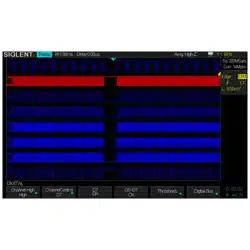Loading ...
Loading ...
Loading ...

SIGLENT
52 SDS2000X User Manual
Trigger Mode
SDS2000X trigger modes include Auto, Normal and Single. The trigger mode affects the
way in which the oscilloscope searches for the trigger
After the oscilloscope begins to capture data, the oscilloscope operates by first filling the
pre-trigger buffer. It starts searching for a trigger after the pre-trigger buffer is filled and
continues to flow data through this buffer while it searches for the trigger. While searching
for the trigger, the oscilloscope overflows the pre-trigger buffer and the first data put into
the buffer is first pushed out. This is also known as a First Input First Out, or FIFO buffer).
When/if a match for the given trigger condition is found, the pre-trigger buffer contains the
events that occurred just before the trigger. Then, the oscilloscope fills the post-trigger
buffer and displays the full acquisition memory.
Press the Auto, Normal or the Single buttons on the front panel to select the desired
trigger mode, and the corresponding status light will be lighted.
In the Auto trigger mode (the default setting), if the specified trigger conditions are
not found, triggers are forced and acquisitions are made so that signal activity is
displayed on the oscilloscope. The waveforms on the display may not be stable or
repeatable in this case, but you should observe some portion of the waveforms.
The Auto trigger mode is appropriate when:
Checking DC signals or signals with unknown levels or activity.
When trigger conditions occur often enough that forced triggers are
unnecessary.
In the Normal trigger mode, triggers and acquisitions only occur when the specified
trigger conditions are found. Otherwise, the oscilloscope holds the original waveform
until the next trigger happens.
The Normal trigger mode is appropriate when:
We only want to acquire specific events specified by the trigger settings.
Triggering on an infrequent signal from a serial bus (for example, I2C, SPI, CAN,
LIN, etc.) or another signal that arrives in bursts. The Normal trigger mode lets
you stabilize the display by preventing the oscilloscope from auto-triggering and
overwriting the current waveform with undesired data.
In the Single trigger mode, the oscilloscope waits for a trigger and displays the
waveform when the trigger condition is met and then stops acquiring data.
The Single trigger mode is appropriate in order:
To capture single event or a periodic signal.
To capture burst or other unusual signals.
Loading ...
Loading ...
Loading ...
